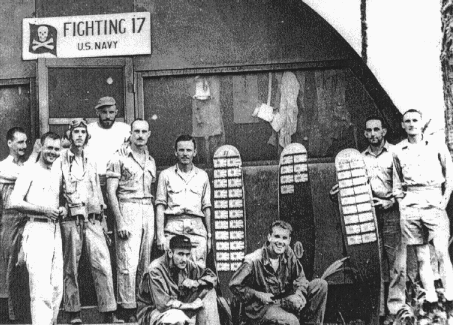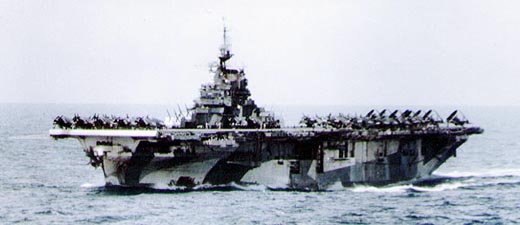VF-17 Squadron
History and Base Locations
The First Home base for VF-17 was the
USS Bunker Hill. Here is a short history of the USS Bunker Hill and the beginning
of the end of the usage of the F4U from a carrier by VF-17 until later in the
war. During the transit to Pearl Harbor VF-17 received word that they were no
longer going to be allowed to operate from the USS Bunker Hill. This
was due to the way logistics would have to operate to keep them supplied while
on board the ship. They  were instead transferred off the
Bunker Hill and sent to Ondonga, New Georgia in October of 1943. VF-17 operated
from Ondonga (which means "the Place of Death" in the local language). During
their operations from Ondonga they covered
the invasion of Bougainville and were moved up to Piva Yoke in January of 1944.
From January to April of 1944 VF-17 was involved with the systematic take down
of Rabaul as an effective base of operations for the Japanese in the Solomon
Islands area. On 10 April 1944 VF-17 was de-established and the personnel were
transferred to other squadrons throughout the US Navy. At this time Lcdr. Roger
Hedrick formed VF-84 and VF-17 was re-established at Alameda Naval Air Station
under command of Lcdr. M.U. Beebe and assigned to the USS Hornet during this
same month. VF-17 then later participated in the invasions of Iwo Jima and Okinawa.
While taking part in the invasions, VF-17 was responsible for knocking down
146.5 Japanese aircraft during fighter sweeps from 18 March to 17 April 1945.
were instead transferred off the
Bunker Hill and sent to Ondonga, New Georgia in October of 1943. VF-17 operated
from Ondonga (which means "the Place of Death" in the local language). During
their operations from Ondonga they covered
the invasion of Bougainville and were moved up to Piva Yoke in January of 1944.
From January to April of 1944 VF-17 was involved with the systematic take down
of Rabaul as an effective base of operations for the Japanese in the Solomon
Islands area. On 10 April 1944 VF-17 was de-established and the personnel were
transferred to other squadrons throughout the US Navy. At this time Lcdr. Roger
Hedrick formed VF-84 and VF-17 was re-established at Alameda Naval Air Station
under command of Lcdr. M.U. Beebe and assigned to the USS Hornet during this
same month. VF-17 then later participated in the invasions of Iwo Jima and Okinawa.
While taking part in the invasions, VF-17 was responsible for knocking down
146.5 Japanese aircraft during fighter sweeps from 18 March to 17 April 1945.
USS BUNKER HILL (CV 17) "The Holiday
Express"
The first ship to bear the name USS BUNKER HILL
was one of the ESSEX Class Fast Carriers. Commissioned May 20, 1943, she quickly
earned the nickname "HOLIDAY EXPRESS" because many of her slashing attacks were
made during the Christmas and New Year's holidays.
The BUNKER HILL was significant improvement of
the ESSEX Class ships over the other U.S. carriers at the time. In addition to
more guns and armament, they were equipped with a more heavily armored deck,
plus a second armored deck on the hangar level designed to detonate
armor-piercing shells and bombs before they reached the vital machinery and
electronic spaces below.
BUNKER HILL was one of the few carriers to
survive through the entire Pacific Island Hopping Campaign to engage the largest
battleship ever built - the YAMATO. In the attack on the Japanese super
battleship, the YAMATO was hit by several bombs and almost a dozen torpedo
strikes to the hull before she finally sank along with five of her escorts. But
the victories of the HOLIDAY EXPRESS and her deadly air wing were soon to come
to an end.
On May 11, 1945, off the coast of Okinawa, two
Japanese aircraft swept down on the BUNKER HILL so quickly that her exhausted
gunners barely had time to respond. The first aircraft released it's 500 pound
bomb which smashed through the flight deck and skidded over the side, destroying
nearly all the ready deck aircraft. The second aircraft dove at the carrier at
nearly a vertical dive, dropping another 500 pound bomb just before it hit the
deck. The bomb smashed through the flight deck, but did not penetrate the hangar
deck where it exploded. The thickened armor protecting the machinery spaces
below had proved effective.
After several hours of fighting fires, BUNKER
HILL was able to sail under her own power to dock for repairs. A total of 346
men lost their lives, 43 were counted missing and 264 had been
wounded.
BUNKER HILL was repaired just as the war had
ended. Her final act of World War II was to bring thousands of servicemen home
from the Pacific Theater. In 1947, she was decommissioned. In the years
following her decommissioning, BUNKER HILL (CV 17) served as an Anti-Submarine
Warfare Support Carrier, a Aviation transport and as an Electronics test ship
before being sold to Zidell Explorations INC in 1973.
During the few short years of active duty in
World War II, BUNKER HILL was awarded eleven Battle Stars and the Presidential
Citation in 1946.
USS Hornet (CV-12 )
1943 - The eighth HORNET (CV-12) was
commissioned just 16 months after her keel was laid.
For 16 continuous months she was in
action in the forward areas of the Pacific combat zone, sometimes within 40
miles of the Japanese home islands.
Under air attack 59 times, she was
never hit.
Her aircraft destroyed 1410 Japanese
aircraft, only ESSEX exceeded this record.
Her air groups destroyed or damaged
1,269,710 tons of enemy shipping.
10 HORNET pilots attained "Ace in a
Day" status.
30 of 42 VF-2 Hellcat pilots were
aces.
72 enemy aircraft shot down in one
day.
255 aircraft shot down in a
month.
Supported nearly every Pacific
amphibious landing after March 1944.
Scored the critical first hits in
sinking the super battleship YAMATO.
In 1945 launched the first strikes
against Tokyo since the 1942 Doolittle Raid.
"A HERITAGE OF EXCELLENCE"
is the ship's creed:
Earned 9 battle stars for her
service in WWII
Awarded the Presidential Unit
Citation for her WWII operations (only nine carriers so cited).
Source:
http://www.bunker-hill.navy.mil/history.htm#CV
http://www.ibiblio.org/hyperwar/USN/ships/CV/CV-17_BunkerHill.html
http://www.uss-hornet.org/history/0~index.html
http://www.ibiblio.org/hyperwar/USN/ships/CV/CV-12_Hornet.html
 were instead transferred off the
Bunker Hill and sent to Ondonga, New Georgia in October of 1943. VF-17 operated
from Ondonga (which means "the Place of Death" in the local language). During
their operations from Ondonga they covered
the invasion of Bougainville and were moved up to Piva Yoke in January of 1944.
From January to April of 1944 VF-17 was involved with the systematic take down
of Rabaul as an effective base of operations for the Japanese in the Solomon
Islands area. On 10 April 1944 VF-17 was de-established and the personnel were
transferred to other squadrons throughout the US Navy. At this time Lcdr. Roger
Hedrick formed VF-84 and VF-17 was re-established at Alameda Naval Air Station
under command of Lcdr. M.U. Beebe and assigned to the USS Hornet during this
same month. VF-17 then later participated in the invasions of Iwo Jima and Okinawa.
While taking part in the invasions, VF-17 was responsible for knocking down
146.5 Japanese aircraft during fighter sweeps from 18 March to 17 April 1945.
were instead transferred off the
Bunker Hill and sent to Ondonga, New Georgia in October of 1943. VF-17 operated
from Ondonga (which means "the Place of Death" in the local language). During
their operations from Ondonga they covered
the invasion of Bougainville and were moved up to Piva Yoke in January of 1944.
From January to April of 1944 VF-17 was involved with the systematic take down
of Rabaul as an effective base of operations for the Japanese in the Solomon
Islands area. On 10 April 1944 VF-17 was de-established and the personnel were
transferred to other squadrons throughout the US Navy. At this time Lcdr. Roger
Hedrick formed VF-84 and VF-17 was re-established at Alameda Naval Air Station
under command of Lcdr. M.U. Beebe and assigned to the USS Hornet during this
same month. VF-17 then later participated in the invasions of Iwo Jima and Okinawa.
While taking part in the invasions, VF-17 was responsible for knocking down
146.5 Japanese aircraft during fighter sweeps from 18 March to 17 April 1945.
